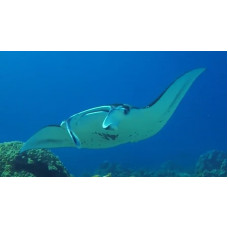Latin name
Mobula alfredi
Other names
Mobula alfredi
Identification
Huge pectoral fins together with the head form a rhombic disc, the width of which is about 2.2-2.4 times the length, reaching 5.5 m in large individuals, although the average does not exceed 3-3.5 m. Representatives of this subfamily are the only vertebrates with three pairs of functional limbs. The length of the slender tail is about 123% of the length of the vertebral column. The mouth is very wide. Unlike other members of the subfamily, it is located on the frontal margin of the head rather than underneath it. The eyes and spatula are on the sides of the head, and 5 pairs of gill slits, five on each side, are on the underside of the head. The spine on the tail is absent. On the lower jaw, small pointed denticles are arranged in 6-8 rows, extending about 22% of the length of the disc. Each row has 142-182 denticles, the total number varying from 900 to 1500.
Features of fish fins
The front part of the pectoral fins becomes the so-called dorsal fins. The length of the dorsal fin is twice the width of its base. Manta alfredi usually curl the pectoral fins into a spiral "horn" shape when moving, and unfold them when feeding to direct the flow of water containing plankton into the mouth. There is a small dorsal fin at the base of the tail.
Fish colouring
Dorsal surface of disc dark grey, dark brown or black, ventral surface pale. Blurred light spots are sometimes present near the head, sometimes forming the background for a dark letter Y. Black dots or elongated markings are often present between the gill slits on the ventral surface. The mouth area is pale. Some individuals are almost entirely black except for a bright white spot on the underside of the disc. Each individual has a unique body colouration. Conical or ridge-shaped plaques are scattered on both sides of the disc.
Distribution
Widespread but fragmented distribution in tropical and subtropical waters of the Pacific, Atlantic and Indian Oceans. In the western Indian Ocean, this species is found from the Sinai Peninsula in the Red Sea to Durban, South Africa, and in the eastern Indian Ocean from Thailand to Perth, Australia. They form mass aggregations in specific locations in Hawaii and the Maldives, in the waters of French Polynesia, Fiji, Indonesia, Mozambique, Australia, Micronesia and the Philippines. In the North Atlantic they are found off the Canary Islands and Cape Verde.
Habitat
Marine, benthopelagic, tropical species. Inhabit coastal waters rich in plankton. They are probably characterised by their attachment to a single habitat. At the same time, observations in Australian, Japanese and Mozambican waters have shown that they are capable of migrating over distances of more than 500 km, swimming 70 km per day.
They swim by flapping their pectoral fins like wings. In the open sea they move at a constant speed in a straight line, but close to the shore they often bask on the surface or circle lazily. They can be found alone or in groups of more than 50.
Size
Maximum length: 500 cm.
Behavior
Manta alfredi often form schools of up to 50 individuals when feeding, breeding and cleaning parasites.
Food and feeding habits
By type of feeding they are filter feeders. The filtering mechanism consists of pinkish-brown spongy plates between the gill arches. The diet is based on zooplankton and fish larvae. Can feed on small fish. Travels great distances in search of food, constantly following the movement of plankton. They find food by sight and smell. When feeding, they swim slowly around their prey, compressing it into a cluster, then accelerate and swim through the cluster of organisms with their mouths open. In the presence of exceptionally large concentrations of food, stingrays, like sharks, can go into a feeding frenzy.
Reproduction
Reproduction by oviparity. Fertilisation is internal. Females reach sexual maturity at 8-10 years of age. Off the coast of Mozambique, males mature at a disc width of about 3 m and females at 4 m. In the waters of the Maldives, these rays mature at smaller sizes - 2.5 and 3 m respectively. The youngest male to show mating behaviour was 6 years old. Life expectancy is estimated at 31 years and some sources suggest they can live to 50.
Fishing
They are craft and also caught as bycatch.
Relationship with a person
The species is not dangerous to humans. The large and harmless reef manta ray is an attractive object for ecotourism. Due to their very large size, only the largest oceanariums can afford to keep manta rays in captivity. Their gill stalks are sought after in Chinese medicine.
| Classification | |
| Phylum | Chordata |
| Class | Chondrichthyes |
| Squad | Myliobatiformes |
| Family | Mobulidae |
| Genus | Mobula |
| Species | M. alfredi |
| Features | |
| Conservation status | Vulnerable |
| Habitat | Pelagic |
| Life span, years | 50 |
| Maximum body weight, kg | No information |
| Maximum length, cm | 500 |
| Sailing speed, m/s | No information |
| Threat to people | Edible |
| Way of eating | Bentophage |
Reef manta ray
Tags: reef manta ray



